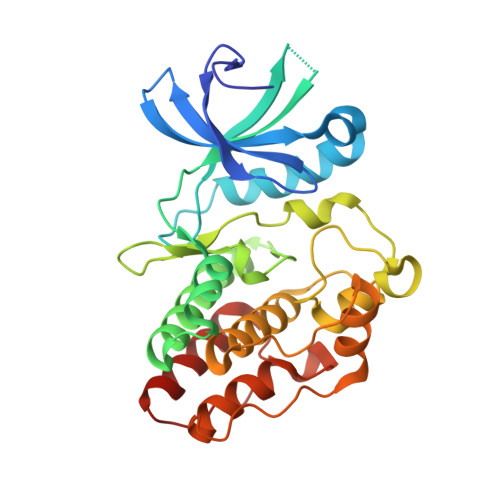Evidence that phosphorylation of threonine in the GT motif triggers activation of PknA, a eukaryotic-type serine/threonine kinase from Mycobacterium tuberculosis.
Ravala, S.K., Singh, S., Yadav, G.S., Kumar, S., Karthikeyan, S., Chakraborti, P.K.(2015) FEBS J 282: 1419-1431
- PubMed: 25665034
- DOI: https://doi.org/10.1111/febs.13230
- Primary Citation of Related Structures:
4OW8 - PubMed Abstract:
Phosphorylation of the activation loop in the catalytic domain of the RD family of bacterial eukaryotic-type Ser/Thr protein kinases (STPK) induces their conformational transition from an inactive to active state. However, mechanistic insights into the phosphorylation-mediated transition of these STPKs from an inactive to active state remain unknown. In the present study, we addressed this issue with PknA, an essential STPK from Mycobacterium tuberculosis. We found that the catalytic activity of PknA is confined within the N-terminal 283 amino acids (PknA-283). The crystal structure of PknA-283 in unphosphorylated form showed an ordered activation loop and existed in an inactive state preventing the phosphorylation of its cognate substrate(s). Peptide mass finger printing studies revealed that all activation loop threonines (Thr172, Thr174 and Thr180) were phosphorylated in the activated PknA-283 protein. Substitution of Thr180 with Ala/Asp (T180A/T180D) resulted in catalytically defective mutants, whereas a double mutant replacing Thr172 and Thr174 with Ala (T172A-T174A) was deficient in kinase activity. Analysis of PknA-283 structure, together with biochemical studies, revealed the possibility of phosphorylation of Thr180 via a cis mechanism, whereas that of Thr172 and Thr174 occurs via a trans mechanism. Moreover, unlike wild-type, these mutants did not show any drastic change in cell morphology in a phenotypic assay, implicating the role of all threonines in the activation loop towards the functionality of PknA. Thus, our findings offer a model for kinase activation showing that the phosphorylation of Thr180 triggers PknA to transphosphorylate Thr172/Thr174, thereby governing its functionality.
Organizational Affiliation:
CSIR-Institute of Microbial Technology, Chandigarh, India.
















